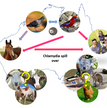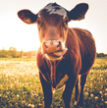- Veterinary microbiology ×
-
One C. psittaci clone to rule them all?
October 24, 2022
Upon the publication of her team's latest paper in Microbial Genomics, Dr Martina Jelocnik gives a behind-the-scenes look at the work of the University of the Sunshine Coast's Chlamydians team, keeping track of veterinary chlamydial infections.
-
Could the gut microbiome influence livestock growth?
October 24, 2018
Dr Stafford Vigors is a researcher at Teagasc, a Food Research Centre in Ashtown, Dublin. At the 2018 Microbes and Mucosal Surfaces Focused Meeting, Stafford presented his research ‘Analysis of the intestinal microbiome of pigs divergent in feed efficiency.’ Here, he explains how differences in the gut microbiome could improve - or hinder - pig growth on farms.
-
Schmallenberg in sheep, a variable virus
May 14, 2013
In 2011, a new animal virus was detected in the German town of Schmallenberg. This virus, which infects sheep and cows, is now sweeping across Europe and was first identified in the UK in 2012. In a new paper published in the Journal of General Virology, researchers in Belgium have found an area of the virus’s genome that is very prone to mutation.
-
New techniques detect BSE in extra-neuronal tissue of cattle
October 24, 2012
Bovine spongiform encephalopathy (BSE) or “Mad Cow Disease,” as it is more publicly known is a transmissible neurodegenerative disease affecting cattle. Importantly, it is also transmissible to humans and there is currently no treatment available. Scientists around the globe are working to better understand the infectious agent that causes the condition – a misfolded prion protein (PrPSc). In a new study, published in the Journal of General Virology, scientists used an improved detection technique to detect PrPSc in peripheral tissue from affected cattle. The findings suggest revised guidelines are needed on material banned from meat destined for animal feed or human consumption. This could help efforts to eradicate this disease.
-
Bats and their viral tenants
August 8, 2012
Bats are an important natural reservoir of gammaretroviruses, a type of retrovirus.




